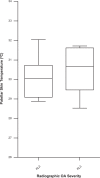Patellar skin surface temperature by thermography reflects knee osteoarthritis severity
- PMID: 21151853
- PMCID: PMC2998980
- DOI: 10.4137/CMAMD.S5916
Patellar skin surface temperature by thermography reflects knee osteoarthritis severity
Abstract
Background: Digital infrared thermal imaging is a means of measuring the heat radiated from the skin surface. Our goal was to develop and assess the reproducibility of serial infrared measurements of the knee and to assess the association of knee temperature by region of interest with radiographic severity of knee Osteoarthritis (rOA).
Methods: A total of 30 women (15 Cases with symptomatic knee OA and 15 age-matched Controls without knee pain or knee OA) participated in this study. Infrared imaging was performed with a Meditherm Med2000™ Pro infrared camera. The reproducibility of infrared imaging of the knee was evaluated through determination of intraclass correlation coefficients (ICCs) for temperature measurements from two images performed 6 months apart in Controls whose knee status was not expected to change. The average cutaneous temperature for each of five knee regions of interest was extracted using WinTes software. Knee x-rays were scored for severity of rOA based on the global Kellgren-Lawrence grading scale.
Results: The knee infrared thermal imaging procedure used here demonstrated long-term reproducibility with high ICCs (0.50-0.72 for the various regions of interest) in Controls. Cutaneous temperature of the patella (knee cap) yielded a significant correlation with severity of knee rOA (R = 0.594, P = 0.02).
Conclusion: The skin temperature of the patellar region correlated with x-ray severity of knee OA. This method of infrared knee imaging is reliable and as an objective measure of a sign of inflammation, temperature, indicates an interrelationship of inflammation and structural knee rOA damage.
Keywords: inflammation; infrared imaging; knee; osteoarthritis; thermography.
Figures


Similar articles
-
Discordance between radiographic findings, pain, and superficial temperature in knee osteoarthritis.Reumatologia. 2020;58(6):375-380. doi: 10.5114/reum.2020.102002. Epub 2020 Dec 23. Reumatologia. 2020. PMID: 33456080 Free PMC article.
-
Assessment of hand osteoarthritis: correlation between thermographic and radiographic methods.Rheumatology (Oxford). 2004 Jul;43(7):915-9. doi: 10.1093/rheumatology/keh204. Epub 2004 May 4. Rheumatology (Oxford). 2004. PMID: 15126670
-
Infrared Thermography in Symptomatic Knee Osteoarthritis: Joint Temperature Differs Based on Patient and Pain Characteristics.J Clin Med. 2023 Mar 16;12(6):2319. doi: 10.3390/jcm12062319. J Clin Med. 2023. PMID: 36983319 Free PMC article.
-
Thermal threshold for knee osteoarthritis people evaluated with infrared thermography: A scoping review.J Therm Biol. 2024 Jul;123:103932. doi: 10.1016/j.jtherbio.2024.103932. Epub 2024 Aug 3. J Therm Biol. 2024. PMID: 39111061
-
Clinical assessment of arthritic knee pain by infrared thermography.J Basic Clin Physiol Pharmacol. 2018 Oct 31;30(3). doi: 10.1515/jbcpp-2017-0218. J Basic Clin Physiol Pharmacol. 2018. PMID: 30375348 Review.
Cited by
-
Infrared thermography in pain medicine.Korean J Pain. 2013 Jul;26(3):219-22. doi: 10.3344/kjp.2013.26.3.219. Epub 2013 Jul 1. Korean J Pain. 2013. PMID: 23861995 Free PMC article. No abstract available.
-
Applications of thermal imaging with infrared thermography in Orthopaedics.J Clin Orthop Trauma. 2021 Nov 29;24:101722. doi: 10.1016/j.jcot.2021.101722. eCollection 2022 Jan. J Clin Orthop Trauma. 2021. PMID: 34926152 Free PMC article.
-
Challenges to Global Implementation of Infrared Thermography Technology: Current Perspective.Cent Asian J Glob Health. 2017 Oct 30;6(1):289. doi: 10.5195/cajgh.2017.289. eCollection 2017. Cent Asian J Glob Health. 2017. PMID: 29138741 Free PMC article.
-
Assessment of Pain and Inflammation in Domestic Animals Using Infrared Thermography: A Narrative Review.Animals (Basel). 2023 Jun 22;13(13):2065. doi: 10.3390/ani13132065. Animals (Basel). 2023. PMID: 37443863 Free PMC article. Review.
-
A comparison of thermal characteristics of the small joints of the hands between patients with rheumatoid arthritis and healthy controls.Arch Rheumatol. 2024 Dec 12;39(4):617-623. doi: 10.46497/ArchRheumatol.2024.10753. eCollection 2024 Dec. Arch Rheumatol. 2024. PMID: 40060131 Free PMC article.
References
-
- Braverman IM. The cutaneous microcirculation. J Investig Dermatol Symp Proc. 2000 Dec;5(1):3–9. - PubMed
-
- Bonelli RM, Koltringer P. Autonomic nervous function assessment using thermal reactivity of microcirculation. Clin Neurophysiol. 2000 Oct;111(10):1880–8. - PubMed
-
- Vainer BG. FPA-based infrared thermography as applied to the study of cutaneous perspiration and stimulated vascular response in humans. Phys Med Biol. 2005 Dec 7;50(23):R63–94. - PubMed
-
- Anderson ME, Moore TL, Lunt M, Herrick AL. The ‘distal-dorsal difference’: a thermographic parameter by which to differentiate between primary and secondary Raynaud’s phenomenon. Rheumatology (Oxford) 2007;46(3):533–8. - PubMed
-
- Maeda M, Kachi H, Ichihashi N, Oyama Z, Kitajima Y. The effect of electrical acupuncture-stimulation therapy using thermography and plasma endothelin (ET-1) levels in patients with progressive systemic sclerosis (PSS) J Dermatol Sci. 1998 Jun;17(2):151–5. - PubMed
Grants and funding
LinkOut - more resources
Full Text Sources
Other Literature Sources
Medical
Miscellaneous

